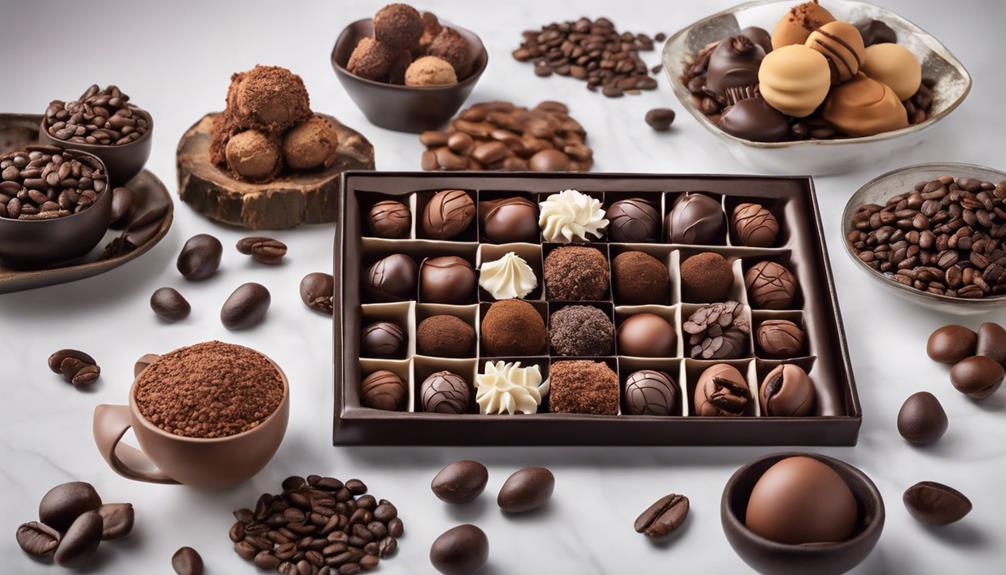When we compare cacao and coffee in 10 key points, we uncover unique facts. Cacao, originating from Central and South America, and coffee, from East Africa and Arabia, have distinct beginnings. Cacao trees grow tall and require years to produce fruit, while coffee beans develop on branches. Both undergo meticulous processing with quality control. Coffee is known for its bold flavor with nutty or fruity notes, whereas cacao offers rich, earthy flavors. Both are versatile in recipes and provide health benefits. Recognizing their differences and similarities enhances our appreciation for these beloved beverages.
Key Takeaways
- Cacao has half the caffeine of coffee and is rich in Theobromine.
- Coffee offers a bold, bitter taste with nutty, fruity, or floral notes.
- Cacao provides a rich, earthy flavor with nutty, fruity, and floral undertones.
- Both cacao and coffee are rich in antioxidants, vitamins, and minerals.
- Sustainability and ethical sourcing are crucial in both cacao and coffee production.
Origins and Botanical Backgrounds
Comparing the origins and botanical backgrounds of cacao and coffee reveals intriguing differences in their geographical roots and plant characteristics. Cacao originated in Central and South America, while coffee originated in East Africa and the Arabian Peninsula.
Cacao trees, scientifically known as Theobroma Cacao, can grow up to an impressive height of 12 meters and take about four years to bear fruit. On the other hand, popular species of coffee trees, Coffea arabica, and Coffea canephora, produce coffee beans along their branches.
The cacao pods contain cocoa beans surrounded by a sweet white pulp that's processed into various cacao products. In contrast, coffee cherries consist of layers like Parchment, Silverskin, Pulp, and Seed, which eventually lead to the production of brewed coffee powder.
Understanding the origins and botanical backgrounds of cacao and coffee sheds light on the unique characteristics and growth patterns of these two beloved plants.
Processing Methods and Production

Exploring the processing methods and production techniques of cacao and coffee reveals the intricate steps involved in transforming their raw ingredients into popular consumable products.
- Roasted Coffee: The post-harvest processing of coffee beans involves steps like pulping, fermenting, washing, drying, hulling, grading, and finally, roasting. The roasting process has a substantial impact on the flavor profile of the coffee.
- Cacao Powder: For cacao powder production, the beans are fermented, dried, roasted at low temperatures, and then crushed into a paste. This paste is pressed to extract the fat, leaving behind the cacao solids that are further ground into a fine powder.
- Quality Control: Both cacao and coffee undergo rigorous quality control measures during processing to ensure consistency and flavor. Factors like bean quality, processing techniques, and storage conditions play critical roles in determining the final product's quality.
- Sustainability Practices: Many producers are adopting sustainable practices in both cacao and coffee production to minimize environmental impact and support ethical practices. These include fair trade certifications, organic farming methods, and biodiversity conservation efforts.
Flavor Profiles and Taste Notes
When comparing cacao and coffee, it's crucial to comprehend their distinct flavor profiles, aromas, and taste nuances.
Coffee features a bold and robust taste with hints of acidity, sweetness, and bitterness, making it a popular choice for various recipes.
On the flip side, cacao provides a rich and earthy flavor with nutty, fruity, and floral undertones, perfect for enhancing the taste of desserts and chocolate-based treats.
Cacao Vs Coffee Flavors
In experiencing the flavors of cacao versus coffee, one immediately notices their distinct and contrasting taste profiles. Here are some key differences between the flavor profiles of cacao and coffee:
- Coffee Flavor: Offers a bold, bitter taste with nutty, fruity, or floral notes depending on origin and roast.
- Cacao Beans Contain: Provides a rich, earthy flavor profile with undertones of fruity, floral, or nutty notes based on bean variety and origin.
- Versatile Usage: Coffee enhances flavors in hot beverages, baking, and savory dishes.
- Enhanced Sweetness: Cacao is essential for adding deep chocolatey richness to desserts and sweet creations.
Understanding these flavor distinctions can help you appreciate the unique characteristics of both cacao and coffee.
Aromas and Nuances
As a coffee enthusiast, I'm captivated by the intricate aromas and nuances that define the flavor profiles and taste notes of this beloved beverage. Coffee offers a diverse range of flavor profiles, including notes of caramel, fruit, and nuts, while cacao delivers rich, earthy undertones with occasional fruity hints.
The aroma of freshly brewed coffee can contain floral, citrus, or spicy notes, creating a sensorial experience that complements its taste. Similarly, cacao emits a deep, robust scent reminiscent of chocolate and earthiness.
These nuances in both coffee and cacao are influenced by various factors such as origin, processing methods, and roasting techniques. Exploring these aromas and nuances adds depth to the appreciation of the distinct flavor profiles each beverage has to offer.
Taste Sensory Experience
Exploring the flavor profiles and taste notes of coffee and cacao reveals a diverse sensory experience that captivates the palate with bold, bitter essences and a range of fruity, nutty, earthy, and floral undertones. When delving into the taste sensory experience of these two delights, here are some intriguing points to ponder:
- Coffee offers a robust and bitter flavor with fruity and nutty undertones.
- Cacao delivers a rich and earthy taste profile complemented by floral, fruity, and nutty notes.
- Coffee's taste notes can range from caramel to citrus, depending on origin and roast.
- Cacao's taste notes can vary from dark chocolate to red fruit, influenced by bean variety and processing methods.
Culinary Applications and Versatility

When considering culinary applications and versatility, both cacao and coffee offer a wide range of uses to enhance various dishes and beverages. Coffee is commonly used in hot beverages, baking, and rubs, thanks to its bold, bitter, and robust flavor profile. On the other hand, cacao, with its bitter, earthy, and rich taste, is frequently utilized in baking, smoothies, and desserts. Coffee's flavor complements sweet dishes, while cacao enhances the taste of chocolate-based desserts. Cacao adds depth and richness to sweet treats, while coffee enhances the savory aspects of dishes. Both coffee and cacao offer versatility in culinary applications, ranging from beverages to desserts, catering to different flavor profiles and preferences.
| Culinary Application | Coffee | Cacao |
|---|---|---|
| Baking | ✓ Bold flavor profile | ✓ Earthy and rich taste |
| Beverages | ✓ Hot beverages | ✓ Smoothies |
| Desserts | ✓ Complements sweet dishes | ✓ Enhances chocolate desserts |
Coffee and cacao bring distinct flavors and characteristics to the table, providing a versatile range of options to elevate your culinary creations.
Health Benefits and Nutritional Value

Cacao and coffee offer distinct health benefits and nutritional value.
We'll compare their nutritional content, give an overview of their impact on health, and discuss how they influence overall well-being.
Let's explore the differences between these two beloved drinks to see how they can contribute to our health.
Nutritional Content Comparison
Comparing the nutritional content of cacao and coffee reveals distinct health benefits and nutritional value differences between the two popular beverages. When looking at their nutritional profiles, here are some key points to take into account:
- Caffeine Levels: Cacao contains half the caffeine of brewed coffee, making it a suitable lower-caffeine alternative.
- Theobromine Content: Cacao has about ten times more Theobromine than caffeine, offering a unique type of energy boost.
- Health Risks: Cacao consumers have lower risks of heart disease, stroke, and diabetes, showcasing its potential health benefits.
- Nutritional Composition: Cacao beans are about equal parts fat and mass, resembling an almond, which contributes to their overall nutritional value.
Health Benefits Overview
Rich in antioxidants, vitamins, and minerals, cacao and coffee offer distinct health benefits and nutritional value that contribute to overall well-being.
Cacao is packed with antioxidants that help fight off free radicals in the body, promoting a strong immune system. It also contains essential vitamins like iron, magnesium, and zinc, which support various bodily functions.
On the other hand, coffee provides a quick energy boost and can enhance focus due to its caffeine content. Additionally, coffee has been linked to a reduced risk of certain diseases when consumed in moderation.
Both cacao and coffee have their unique advantages when it comes to health benefits, making them valuable additions to a balanced diet.
Impact on Well-Being
Enhancing overall health and energy, both cacao and coffee provide distinctive health advantages and nutritional value that cater to various aspects of one's well-being. When considering the impact on well-being, it's crucial to understand the differences between these two beloved beverages:
- Cacao is rich in antioxidants, promoting immunity and overall health.
- Coffee consumption is linked to a reduced risk of cardiovascular diseases and certain types of cancers.
- Cacao has minimal caffeine compared to coffee, making it a suitable option for those with caffeine sensitivities.
- Theobromine in cacao offers sustained energy without the jittery effects commonly associated with caffeine.
Roasting Techniques and Effects

Roasting techniques greatly influence the flavor profiles of both cacao and coffee beans, with each necessitating unique approaches to achieve ideal taste development. Coffee beans thrive under hot-and-fast roasting methods, where high temperatures quickly develop their flavors through audible cracking.
On the other hand, cacao beans prefer a low-and-slow roasting process at lower temperatures to maintain their delicate chemical precursors, enhancing their unique flavors. While coffee beans require rapid cooling post-roasting to halt the process and preserve their developed flavors, cacao beans also benefit from this quick cooling method to lock in their distinct taste profiles.
Understanding these specific roasting techniques is important in bringing out the best flavors from both cacao and coffee beans, ensuring a delightful sensory experience with every sip or bite.
Environmental Impact and Sustainability

Cacao farming stands out as a more sustainable choice compared to coffee production due to its compatibility with shaded agroforestry systems, which help preserve biodiversity. When considering environmental sustainability, cacao farming has several advantages over coffee production:
- Biodiversity Preservation: Cacao cultivation in shaded agroforestry systems supports a diverse ecosystem, unlike coffee plantations that often lead to deforestation.
- Longevity and Efficiency: Cacao trees have a longer lifespan and can produce beans for decades, reducing the need for frequent replanting, which is common in coffee cultivation.
- Soil Health: Cacao farming practices, such as intercropping with shade trees, help maintain soil health and prevent erosion, ensuring long-term sustainability of the land.
- Water Conservation: Cacao's lower water requirements compared to coffee make it a more environmentally friendly crop, particularly in regions facing water scarcity challenges.
Historical Significance and Cultural Influences

Coffee and cacao have rich histories that have shaped cultures worldwide. Understanding their origins, traditions, impact on society, and cultural practices offers valuable insights into the global significance of these beloved beverages.
Let's explore how these drinks have influenced societies and traditions in various parts of the world.
Origins and Traditions
With their distinct origins in different parts of the world, both cacao and coffee have rich historical significance and cultural influences that continue to shape their consumption patterns today.
- Coffee originated in East Africa and the Arabian Peninsula, while cacao originated in Central and South America.
- Coffee gained popularity in Europe in the 17th century, while cacao-based drinks were limited to Central and South America.
- Coffee and chocolate houses emerged in Europe, showcasing clear preferences for each beverage.
- Historical traditions show that coffee was consumed in East Africa and the Arabian Peninsula, while cacao-based drinks were enjoyed in Central and South America.
Impact on Society
Emerging from their respective origins, both cacao and coffee have left indelible marks on society through their historical significance and cultural influences.
Coffee houses, which originated in Europe in the 17th century, became hubs for social gatherings and intellectual discussions, shaping the way people interacted and exchanged ideas.
On the other hand, cacao-based beverages, initially limited to Central and South America, eventually gained popularity in Europe, leading to the rise of chocolate houses where individuals indulged in the rich flavors of cacao.
The cultural influences of coffee were deeply rooted in East Africa and the Arabian Peninsula, where it played a significant role in shaping rituals and traditions.
Both cacao and coffee have played pivotal roles in global trade and cultural exchanges, highlighting their enduring impact on societies worldwide.
Cultural Practices
Indelibly intertwined with the fabric of societies across the globe, the historical significance and cultural influences of cacao and coffee have shaped consumption habits and preferences in distinct ways.
- Coffee houses emerged in Europe in the 17th century, showcasing a clear preference for coffee over cacao-based drinks.
- Cacao was limited to Central and South America, while coffee was widely consumed in East Africa and the Arabian Peninsula historically.
- The cultural influence of coffee and cacao spread differently in various regions, shaping consumption habits and preferences.
- Coffee and chocolate houses were popular meeting spots where people gathered to socialize and discuss business, politics, and literature.
Market Trends and Consumption Patterns

Market trends and consumption patterns in the coffee and cacao industries reveal significant differences in production volumes and market values.
In 2019, the global coffee industry produced a whopping 10.2 million metric tons, valued at $22.84 billion, while the cacao industry, in comparison, produced 4.85 million metric tons, worth $11.85 billion.
Notably, the average price for coffee stood at $1.02 per pound, just slightly lower than cacao at $1.05 per pound. Partners earned three times more for shelled cacao beans, underscoring the stark differences in market value between the two commodities.
Despite these differences, both industries face challenges in valuing the labor involved in growing, harvesting, and processing their products, which should plausibly be higher than the current price per pound.
These market trends and consumption patterns shed light on the disparities in production volumes and market values between coffee and cacao, highlighting the complexities of the global agricultural economy.
Brewing Methods and Beverage Varieties

When brewing coffee or cacao, the approach utilized plays a crucial role in extracting the flavors and creating a distinct beverage. Here are some key points to contemplate:
- Coffee Brewing Methods: Coffee is commonly brewed through techniques like drip, espresso, French press, and pour-over, each offering a unique taste profile.
- Cacao Brewing Techniques: Cacao can be brewed by steeping roasted cacao beans in hot water or through methods like cold brewing and French press, resulting in a rich chocolatey drink.
- Flavor Varieties: Both coffee and cacao provide a wide range of tastes based on the brewing method and the quality of the beans used.
- Beverage Diversity: Exploring different brewing approaches allows for a diverse array of coffee and cacao beverages, catering to various preferences and taste preferences.
Understanding the brewing methods and experimenting with different techniques can lead to discovering new and exciting flavors in your favorite beverages.
Frequently Asked Questions
Is Cacao Better for You Than Coffee?
I believe cacao is better for me than coffee. It offers antioxidants, magnesium, and low calories. Cacao's benefits, like improved mood, reduced stress, and minimal caffeine, make it a healthier choice for my well-being.
How Can You Compare Coffee and Cocoa?
I find comparing coffee and cacao fascinating. Each has unique flavors and histories. Coffee perks me up in the mornings with its caffeine kick, while cacao's rich taste in chocolate is my sweet indulgence.
How Closely Related Are Cacao and Coffee?
Cacao and coffee share a botanical relationship as members of the same plant family, Rubiaceae, showcasing their connection. While originating in different regions, they thrive in tropical climates, contributing to their similar growth environments.
What Are the Similarities Between Coffee and Cacao?
Both coffee and cacao offer a rich, complex flavor profile. They both provide a delightful energy boost and are versatile in recipes. Whether in a steaming cup of coffee or a decadent chocolate treat, they bring joy to my palate.
Is Cacao a Good Alternative to Coffee in Terms of Taste and Benefits?
Looking for delicious cacao coffee alternatives? Cacao is a great option that offers a rich and satisfying taste, while also providing numerous health benefits. It contains antioxidants, vitamins, and minerals that can boost mood and energy levels without the jitters often associated with coffee. Try cacao for a tasty and healthy pick-me-up.
Conclusion
To sum up, both cacao and coffee offer unique flavors, health benefits, and cultural significance. While some may prefer the boldness of coffee, others may enjoy the rich complexity of cacao. Despite personal preferences, both beverages have their own merits and can be enjoyed in a variety of ways.
So, whether you're sipping on a cup of coffee or indulging in a piece of chocolate, take a moment to appreciate the history and craftsmanship behind these beloved treats.

















